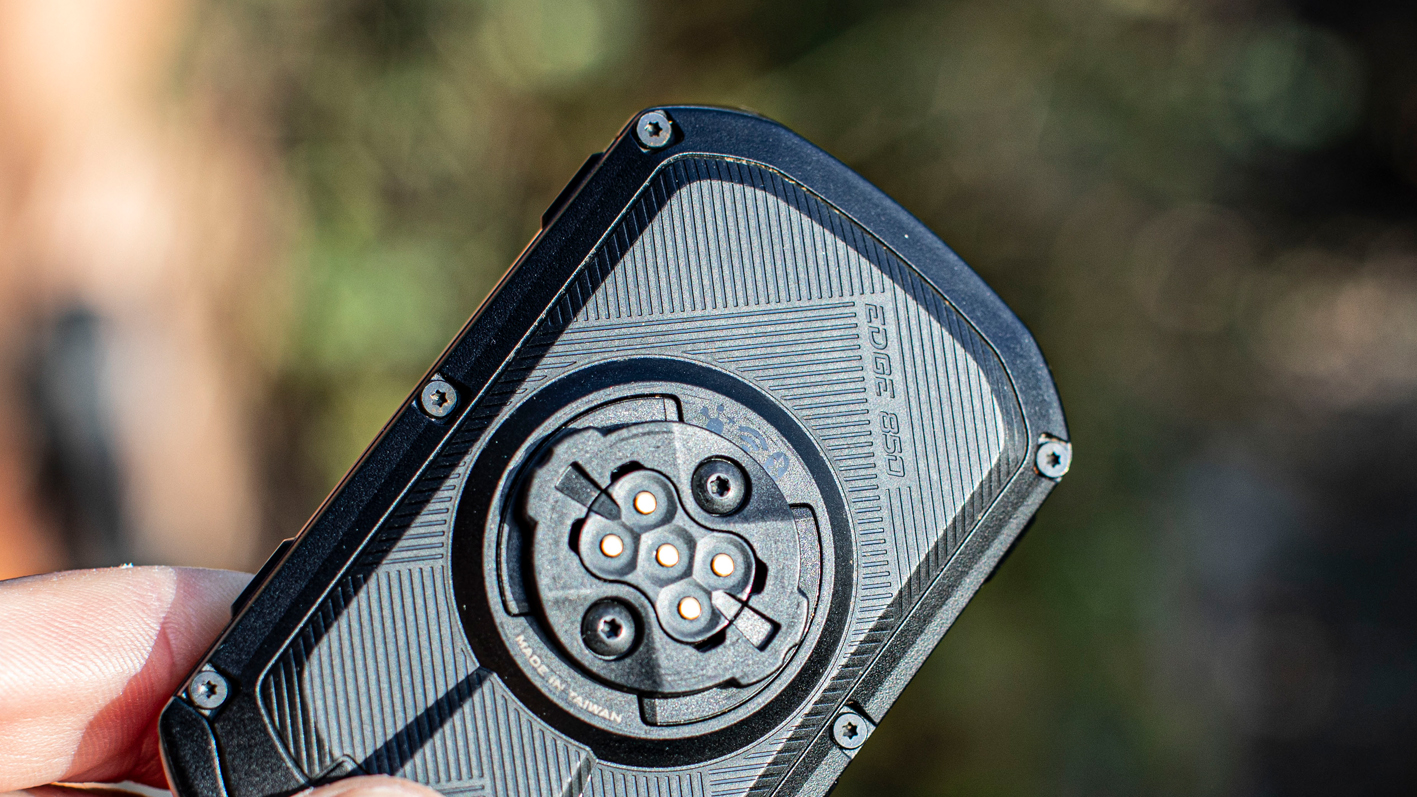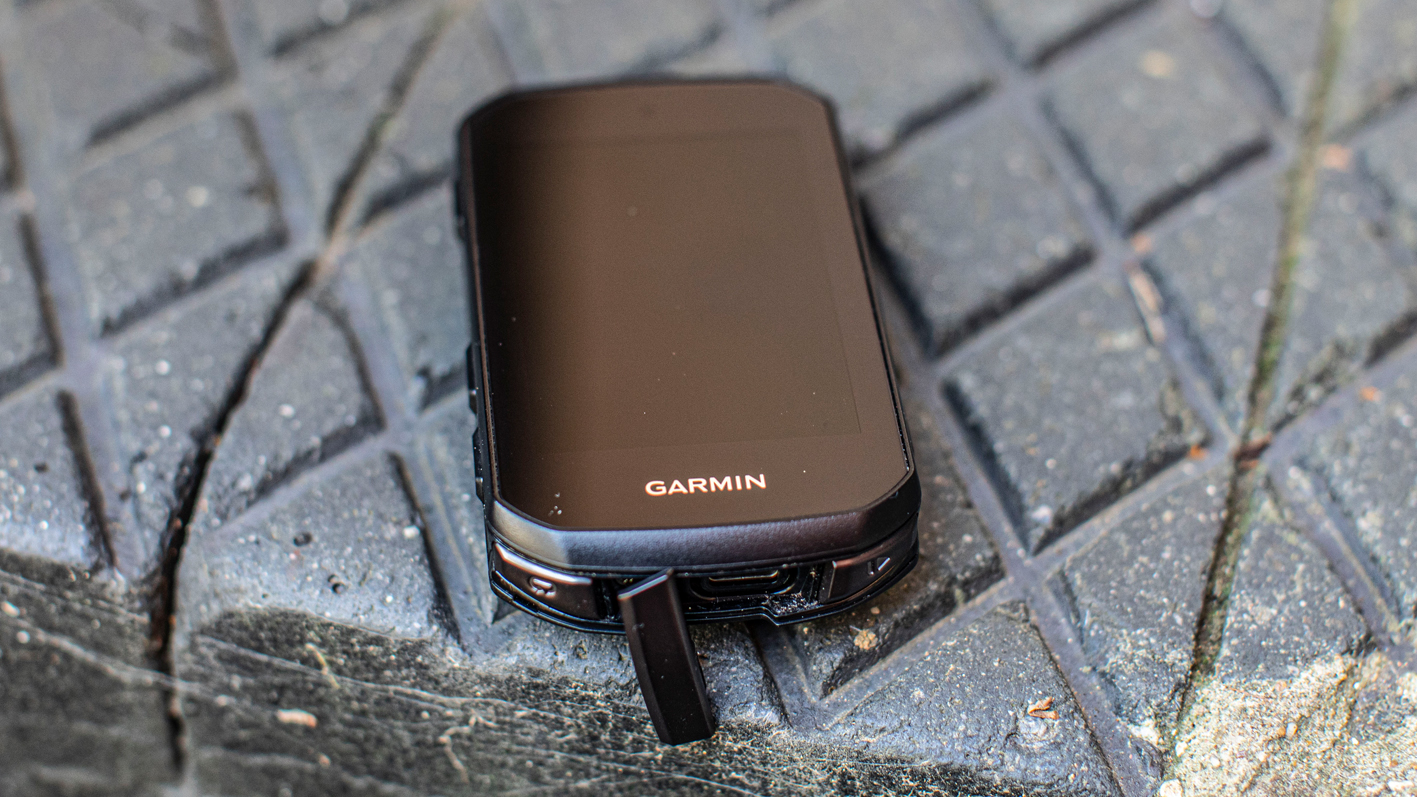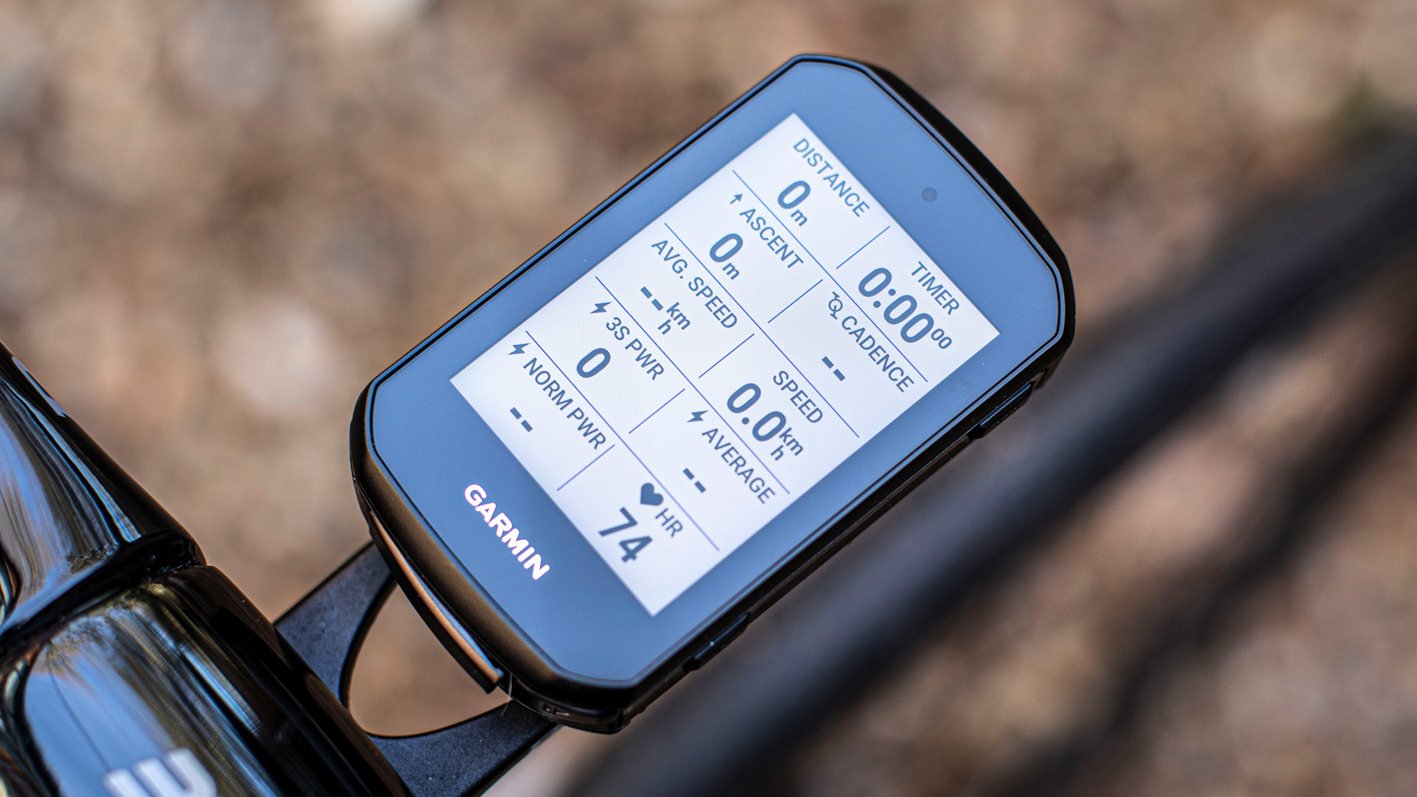Garmin Edge 850 cycling computer review: brilliant in almost every way
All the features you can imagine, but with a cost to battery life

The segment leader retains its crown but could do with better battery life.
-
+
Crisp, bright screen
-
+
Comprehensive feature list
-
+
Digital bell
-
+
Class-leading touchscreen
-
+
Warning alerts and navigation
-
+
Refined aesthetics
-
-
Drops connections after entering auto-sleep mode even during pausing at a coffee stop
-
-
No solar
-
-
Battery life
-
-
Pricey
You can trust Cycling Weekly.

Garmin is the OG of GPS cycling computers, having forged a reputation built on reliability, metric tracking, and navigational excellence. The Edge range of the best bike computers is improving its formula with every iteration, but mounting pressure from rival brands Wahoo and Hammerhead, as well as outliers Bryton and Coros, is eroding its positioning within the market.
With its new Edge 850, Garmin is looking to win back lost votes, but will features borrowed from the range-topping Edge 1050 really do the trick, or has the company merely attempted to over-engineer and overprice one of its most popular devices to stay relevant?

For the first time in years, there's an Edge 850 inscription on the underside to help users distinguish it from other models in the range
Design details
Garmin knows how to create cycling computers with visual drama and the new Edge 850 has taken things to another level. The device features beautiful sculpted shapes, chamfered corners, bevelled edging, and is finished in a combination of textured, matte, and glossy black plastics. Closer inspection also reveals an Edge 850 inscription on the underside to help users distinguish it from other models in the range, a feature that has been missing in previous models. It all looks very refined and polished.
Like earlier generations of the Edge 800 range, it utilises a touchscreen interface and physical buttons, giving users a choice of how to operate things. There are seven buttons in total: three buttons on the left side (power at the top, scroll buttons below), two buttons on the right (return and a button to open the main menu) and a couple on each side of the USB-C charging port on the bottom (lap/back and start/stop).
At 54.6 x 92.2 x 16.8mm, it's longer than before but also narrower and thinner in profile. This has done little to drop any lard over its forebear as the Edge 850 tips the scales at 112g (actual), 27g heavier than before. While this does represent a significant hike over the Edge 840, it does come with myriad features and a superior screen, which we will discuss below.
For context, the Hammerhead Karoo 3 weighs 125g, the Wahoo Elemnt Roam 3 is 109g, and the Coros Dura is lightest cycling computer of the bunch, tipping the scales at 98g.

Charging is carried out via a USB-C port at the bottom
Specifications
The feature list is quite substantial and represents a significant leap over its predecessor, with a super-bright 2.7-inch transmissive LCD with a resolution of 420×600, a faster processor, a speaker for audible turn prompts and a bike bell, and Garmin Pay. It's also IPX-7 water-resistant.
Other headline features include 64GB of data storage, faster map rendering and scrollability, 5Hz GNSS sampling, and more detailed weather widgets that update in real time. On-device navigation has been radically improved with a new address search feature and round‑trip route creation – both have been a long time coming. The audible prompts are a great touch too, both for navigation and for warnings.
In terms of maps, two pre-loaded regions come standard depending on where you purchased the unit - for European users, this includes Europe and the United Kingdom. If you require more maps when travelling, there are free, full‑fidelity, global maps available for download.
Despite Garmin releasing the Edge MTB cycling computer, the 850 can double up for off-road use thanks to features such as Forksight mode, with gives you early warning of a fork in the trail, and enhanced MTB profiles, timing gates, 5Hz GPS for descents, and Trailforks integration, making it easily the most versatile cycling computer currently on the market.

The Edge 850 screen is the brightest and crispest among its rivals
Set-up
In the box, you'll get an Edge 850 GPS cycling computer, an out-front bar mount, a standard 'universal' mount with rubber elastics, a tether, a USB-C charging/data cable, and an instruction manual.
It's a pretty straightforward set-up, especially if you're a current Garmin user. If you aren't, the experience is intuitive, and you'll be ready to roll in no time. First, power on the 850 and ensure it's fully charged. You'll need to follow the on-screen instructions for the initial setup, which involves pairing the device with your phone and/or Wi-Fi network. This is necessary to receive notifications and sync your activities with Garmin Connect and other third-party apps such as Training Peaks and Strava.
At this time, it's recommended that you carry out any software updates to ensure smooth operation, and make sure you're running the most up-to-date version.
The next step is to organise and personalise your profile pages. Here, you'll be greeted by three main activity profiles: Road, Mountain Bike, and Indoor (these are standard, but can be renamed to suit you). In each profile, you'll be able to personalise and set up data screens comprising the metrics and fields you'd like to view while riding. You can set up multiple data screens, with a maximum of 10 data fields per screen. These data screens are in addition to a few standard screens, such as the navigation screen.
Once you've compiled the data fields you'd like to track, it's worth pairing sensors, such as heart rate and power, to name a few. Of course, there are other settings you can enable/disable - these include Climb Pro, Live Segments, Alerts and Prompts, and Nutrition/Hydration.

Aaron is Cycling Weekly's tech writer. With 20 years' experience writing about cars and bikes, he has a deep understanding of dynamics and how things work. Having raced across most cycling disciplines all over the world, he has a keen interest in time trial, gravel, road cycling, mountain biking, and cycling eSports. While he has captained and raced for South Africa at the 2022, 2023, and 2024 UCI Cycling eSports World Championships, his next mission is to dip under 19 minutes in the 10-mile time trial.
Navigation and performance
The touchscreen response and operation are superb, even when using gloves. I didn't have any issues with raindrops affecting the screen and changing things, but if that does become a problem, you can always lock the screen. That said, I do prefer the analogue experience afforded by physical buttons and used these for most of my testing. You can also pair the Edge 850 with your electronic shifters and use the shifter buttons to control the computer if you wish.
The mapping and navigation are brilliant and without issue. If you’re not at the start point when you load the course, it’ll offer to route you there, or you can ignore it and ride to the start point yourself. Once you're close enough to that start, the Garmin will notify you with 'Course Found' - it's all very intuitive. Regardless of what data page you've selected, you’ll get prompts as you approach a turn, as well as a mini-map pop-up screen. You'll get a similar prompt if you veer off course. Other than that, navigation is brilliant, and on par with the Hammerhead Karoo 3, a device I reckon is the benchmark for accurate routing.
ClimbPro is a nifty feature, too, and works on both planned routes and free riding. This can be disabled if you prefer not to know the length of a climb, but it's also handy for pacing on group rides, races, or for trying to scalp your mate. A lot of the other Garmin staples, including Garmin Coach, workouts from Garmin Connect and TrainingPeaks and automatic workout suggestions, are unchanged.

In each profile, you'll be able to personalise and set up data screens comprising the metrics and fields you'd like to view while riding. Data fields are capped at 10 per page
The battery life is probably its weakest point, with a claimed 12 hours of use in demanding conditions. This can be mitigated by using battery saver mode, reducing sensor connections or, as a worst-case scenario, deactivating navigation. While solar technology could solve this with ease, it's not available at the moment and would undoubtedly drive up prices in any case. That said, we do see Garmin re-introducing a solar version in the future to help address the battery conundrum.
During my testing, I'd regularly get 12-18 hours per charge, which doesn't really bother me, as I don't do so many epic rides; my longest rides range from 4-6 hours, depending on the route or race. Personally, the battery life posed no issue for me, as I find anything over 10-12 hours ideal for a week's worth of outdoor riding.
For me, the biggest bugbear was the drop in sensor connections after entering auto-sleep mode while pausing at a coffee stop. This is apparently a known issue for Garmin Edge computers and an annoying one to say the least. According to Garmin, known workarounds include disabling Auto Sleep or rebooting the device mid-ride. I've since disabled the former, and this seems to have solved the issue.

The Garmin Edge 850 vs its rivals, the Coros Dura, Wahoo Elemnt Roam 3 and Hammerhead Karoo 3
Value
At £469.99 / $599.99 / €549.99, the Garmin Edge 850 is not what you'd call cheap, especially considering its arch rivals, the Wahoo Elemnt Roam 3 and Hammerhead Karoo 3 come in at £399 / $464.99 / €499.99 and £449.99/ $524.99 / €499.95, respectively.
The Edge 850, however, has moved the goal posts as far as mid-level cycling computers are concerned, cramming in many of the premium features that make the Edge 1050 such a superb device with a super-fast processor, fantastic screen (both in terms of touch performance and optics), and navigational prompting able to match the Karoo 3. Of the three options, the Edge 850 has the best screen, build quality, and response time, but unfortunately loses out on battery life. In this segment, battery life has, for some reason, become a defining feature in purchasing decisions, and it was perhaps remiss of Garmin to neglect it.
While the Roam 3 is the easiest to use, benefits from a digital bell feature, and has superior battery life to the Garmin, it's not quite as refined from a navigational perspective, and I often find myself missing turns due to the refresh rate and incorrect zoom setting. That said, you can't ignore the exceptional price point Wahoo has achieved with the Roam 3 and easy user experience.
The Karoo 3 is up there in terms of navigation and is close to the best-in-class in that regard, but it has a somewhat complicated interface. That said, once you've played around with the settings and functionality and become familiar with it, it makes sense. Rated at 15+ hours, its battery life is similar to the Garmin Edge 850, but it is also the second-most-expensive unit of the three listed here.

Visually, it retains Garmin's design DNA and fits in well with the Edge range
Overall, it comes down to personal preferences and brand cachet, the latter of which is an advantage to Garmin. As it stands, no other company has a companion app as comprehensive as Garmin Connect, and, if you've been using the Garmin ecosystem for a while, it's easy to buy a new Garmin and plug it in. For me, the Garmin Edge 850 has brought premium features to the mid-size cycling computer game with an unmatched screen, CPU, and overall user experience. While its battery life is on the smaller side - for now at least - I suspect a solar option will be Garmin's next port of call.
That said, there are loads of other options to choose from if you're looking for one of the best bike computers. This includes the Garmin Edge 840 and the Wahoo Element Roam 2, both of which are likely to be on sale this Black Friday and Cyber Monday. To ensure you don't miss out, take a scroll through our Black Friday Bike Deals hub.
Verdict
Despite the battery life, the Garmin Edge 850 represents the pinnacle of the mid-sized cycling computer segment. It's a polished device packed with all the features you could ever need as a cyclist.
Tech spec: Garmin Edge 850
Dimensions: 54.6 x 92.2 x 16.8mm/2.15 x 3.63 x 0.66"
Touchscreen : Yes
Colour display : Yes
Display size: 6.8cm/2.7"
Weight : 112g/4.1oz
Battery life: Claimed up to 12 hours (demanding use)
Compatibility/features: GPS, GLONASS and Galileo. Barometric, altimeter, Gyroscope, Accelerometer, Ambient light sensor, Magnetometer, Bluetooth, ANT+, Wi-Fi
Companion app: Yes
The latest race content, interviews, features, reviews and expert buying guides, direct to your inbox!

Aaron is Cycling Weekly's tech writer. As the former editor of off.roadcc, tech editor of Cyclingnews and Bike Perfect, digital editor of Bicycling magazine and associate editor of TopCar, he's travelled the world writing about bikes and anything with wheels for the past 20 years. As a racer, he's completed stage races such as the Cape Epic, Berg and Bush, W2W, and Gravel Burn. On the road, he’s completed the Haute Route Alps, represented South Africa at the UCI Gran Fondo World Championships Road Race and Time Trial and is an accomplished eSports racer, too - having captained South Africa at the 2022, 2023 and 2024 UCI Cycling eSports World Championships.
You must confirm your public display name before commenting
Please logout and then login again, you will then be prompted to enter your display name.